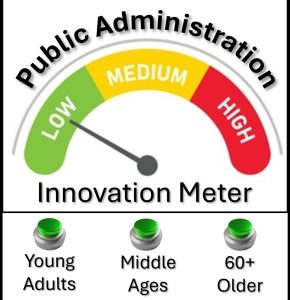Widgetized Section
Go to Admin » Appearance » Widgets » and move Gabfire Widget: Social into that MastheadOverlay zone
Creative Public Administration (Who Cares the Most?)
The views expressed are those of the author and do not necessarily reflect the views of ASPA as an organization.
By Marvin. N Pichla
February 7, 2025

Have you ever heard anyone use the words: Creative Public Administration…in a sentence or professional discussion? Do public servants use creativity as a job performance criteria or is it more important for those using public tax-payer dollars to follow standard expectations? And when one considers these questions… given our voting public… has anyone thought about: Who Cares The Most?
The primary mission of this ASPA quarterly article will be to offer observational research discussions about the different voting age groups and their potential interest in Creative Public Administration. Today, I believe it is critical to give extra attention to generational differences of interest in public administration innovations and experimentation. For professional disclosure reasons the observational research creativity information assembled in this article did not follow traditional data collection methods or procedures. Rather it was generated by input gleaned from public meetings, college course instructional discussions and participation in public service program implementation and performance evaluations.
Let’s begin our discussion with observations taken from those ages 60+. Some may refer to this group as the “Older Generation” but because I now operate inside this segment of the U.S. population… lets just use 60+ as the identifier! First, as one participates in discussions with this group individually or multiple members, it becomes clear that health care and retirement costs are their main concerns. Appropriately, their public administration expectations are mostly “traditional” which means that they hope taxes stay low and social security payments remain consistent.
It is not a surprise that those 60+ are fearful of change in either of these life support/funding factors. Although they are aware of Creative Public Administration developments that are driven by advances in the area of technology… they are not easily convinced that these internet impacts are beneficial. Hand writing payment checks and getting mail from the postal system remains their most appreciated forms of public service interaction.
A final area of Creative Public Administration deserving brief discussion from those 60+ is their still strong respect for elected public officials. Do they recognize the negative aspects of divisive party politics… yes… but do they still believe those in power will most often “do the right thing”… yes.
Moving on to Middle-Aged (ages 36-59) eligible voters in the United States and their views on Creative Public Administration (Who Cares The Most?), one observes that their concern areas are very different than the 60+ segment. Initially it appears that job security, the growing cost of living and costs related to assisting their children in attaining a good job… are their principle challenges. However, hidden a little deeper in their hearts and minds is a growing “apprehension-phobia” regarding faith in the governmental system and a love-hate relationship with everyone’s reliance on the ever expanding techno-systems!
Observation research from Middle-Agers reflects an evaporating trust and confidence in those elected to public service positions at any level. As a result there appears to be an ongoing internal debate whether Creative Public Administration possibilities could be a great thing versus a feeling that too much change will be a problem. Likewise, the Middle-Aged group has trouble dealing with the infighting between the two major political parties. Being forced to “choose sides” and not just choose and vote for the better public service idea or individual… just has weakened the U.S. citizenship strength existing in this age group.
As one assesses the Creative Public Administration (Who Cares The Most?) views of those 18-35, it almost appears that this age group quietly avoids public sector involvement. If one were to statistically measure how many U.S. citizens from this age group seem to be seeking a job in public service… the numbers may reflect a very low percentage. Additionally with the continual growth of communications from online options and whether they trust any governmental information is really accurate… employment interest within the 18-35 group seems to lessen year after year.
Lastly, it is important to note that voters in the 18-35 age range seem to want traditional governmental services and programs… but want access to them on their new-age formats… online! The speed, efficiency and transportability of public services available in an internet format may seem like a natural evolutionary process… but this age group seeks immediate gratification… for everything. Therefore their patience with governmental service transformation is very short and serves to lessen their faith in the overall system.
The simple goal of this Creative Public Administration (Who Cares The Most?) discussion article is to draw increased attention and understanding of the governmental concerns of our country’s age groups. In my view the need for quality, multi-purposed creativity/innovation within all divisions of government is absolutely necessary and long overdue. However as the article reports, any and all progressive public sector operational/service improvements must include appropriate adaption related to our differing age groups.
Interestingly the need for renewed public trust is prevalent within all three age groups. Additionally each age group recognizes that modern technology is and will forever be an innovative factor in designing our public sector departments and programs. Therefore, tomorrow’s Creative Public Administration will require a high level of institutional compromise to be comprehensively successful.
Author: Marvin N. Pichla, Ph.D., is the owner and creative adviser of Inspiring Innovations, Inc. Sharing his unique entrepreneurship and innovation in public service experience, Marv consults with public and private business, education and community organizations to develop new and different problem-solving methods through real-life, example-based learning.


Follow Us!